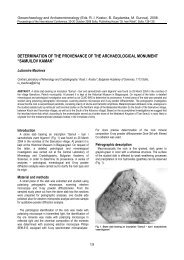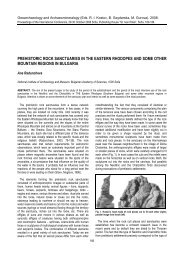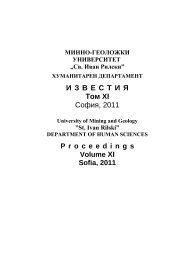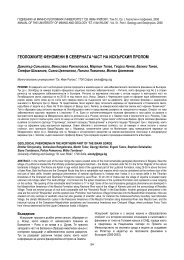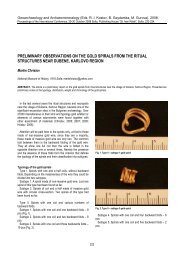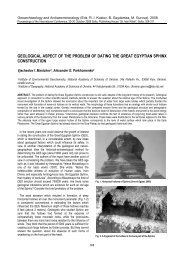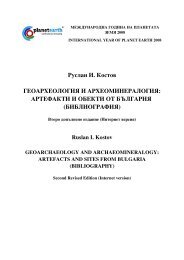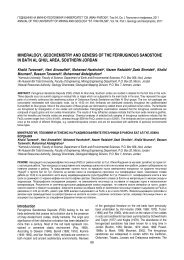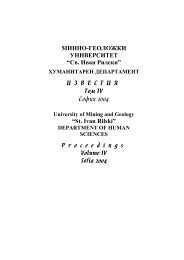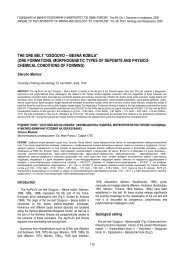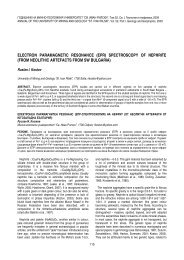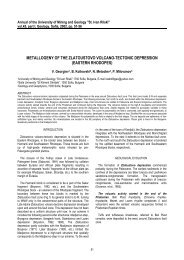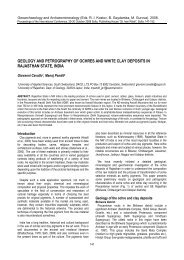archaeological evidence for the exploitation of gold ore deposits at ...
archaeological evidence for the exploitation of gold ore deposits at ...
archaeological evidence for the exploitation of gold ore deposits at ...
You also want an ePaper? Increase the reach of your titles
YUMPU automatically turns print PDFs into web optimized ePapers that Google loves.
Geoarchaeology and Archaeomineralogy (Eds. R. I. Kostov, B. Gaydarska, M. Gurova). 2008.<br />
Proceedings <strong>of</strong> <strong>the</strong> Intern<strong>at</strong>ional Conference, 29-30 October 2008 S<strong>of</strong>ia, Publishing House “St. Ivan Rilski”, S<strong>of</strong>ia, 266-270.<br />
ARCHAEOLOGICAL EVIDENCE FOR THE EXPLOITATION OF GOLD ORE DEPOSITS AT<br />
THE VILLAGES OF KOLIO MARINOVO (SARNENA GORA MOUNTAIN) AND BABYAK<br />
(WESTERN RHODOPES) IN ANTIQUITY<br />
Milena Tonkova<br />
N<strong>at</strong>ional Archaeological Institute and Museum, Bulgarian Academy <strong>of</strong> Sciences, 1000 S<strong>of</strong>ia; milen<strong>at</strong>onkova@hotmail.com<br />
ABSTRACT. Archaeological <strong>evidence</strong> <strong>for</strong> <strong>the</strong> <strong>exploit<strong>at</strong>ion</strong> <strong>of</strong> <strong>gold</strong> <strong>ore</strong> <strong>deposits</strong> <strong>at</strong> <strong>the</strong> villages <strong>of</strong> Kolio Marinovo (Sarnena Gora Mountain) and<br />
Babyak (Western Rhodopes) in antiquity are traced <strong>at</strong> <strong>the</strong> current study. The methodic <strong>of</strong> study consists in restor<strong>at</strong>ion <strong>of</strong> settlement system<br />
established around ancient mining galleries where <strong>archaeological</strong> m<strong>at</strong>erials were found. According to <strong>archaeological</strong> researches made <strong>at</strong> <strong>the</strong> region<br />
<strong>of</strong> <strong>the</strong> mines <strong>of</strong> Kolio Marinovo and near <strong>the</strong> sanctuary <strong>of</strong> Babyak <strong>the</strong>re is many <strong>evidence</strong>s th<strong>at</strong> <strong>the</strong> mines were also used during <strong>the</strong> Pre-Roman<br />
and Roman period.<br />
The map <strong>of</strong> <strong>the</strong> ancient <strong>gold</strong> and silver <strong>deposits</strong> from Thrace<br />
(from <strong>the</strong> territory <strong>of</strong> Bulgaria) (Fig. 1) is compiled on <strong>the</strong> basis<br />
<strong>of</strong> several studies. The most important are those from <strong>the</strong> First<br />
Intern<strong>at</strong>ional Symposium <strong>of</strong> History <strong>of</strong> Mining in Sou<strong>the</strong>ast<br />
Europe held in Bulgaria in <strong>the</strong> 80-es <strong>of</strong> <strong>the</strong> XX c. (First<br />
Symposium on <strong>the</strong> History <strong>of</strong> Mining in South-East Europe,<br />
1975) and <strong>the</strong> study <strong>of</strong> G. Georgiev on <strong>the</strong> traces <strong>of</strong> ancient<br />
mining in our lands (Georgiev, 1987). It was a good beginning,<br />
Fig. 1. Map <strong>of</strong> <strong>the</strong> ancient <strong>gold</strong> and silver <strong>deposits</strong> from <strong>the</strong> territory <strong>of</strong> Bulgaria<br />
266<br />
un<strong>for</strong>tun<strong>at</strong>ely th<strong>at</strong> was left without constant extension, <strong>for</strong> <strong>the</strong><br />
exchange <strong>of</strong> knowledge between geologists and<br />
archaeologists on <strong>the</strong> problems <strong>of</strong> this boundary <strong>for</strong> both<br />
scientific disciplines. The ancient <strong>gold</strong> mining d<strong>at</strong>a have been<br />
reviewed and discussed in rel<strong>at</strong>ion to <strong>the</strong> localiz<strong>at</strong>ion <strong>of</strong><br />
jewellery workshops, some <strong>of</strong> which are known to have exist in<br />
<strong>the</strong> close vicinity (Tonkova, 1994, 183-188; 1999).
On <strong>the</strong> base <strong>of</strong> <strong>the</strong> published sources <strong>the</strong> conclusion can<br />
be drawn th<strong>at</strong> <strong>for</strong> most known examples one can speak only <strong>of</strong><br />
ancient <strong>gold</strong> mining without having d<strong>at</strong>a allowing chronological<br />
decisions to be done from <strong>the</strong>se findings. Only in certain cases<br />
<strong>the</strong> <strong>archaeological</strong> chance has made possible discovery <strong>of</strong><br />
m<strong>at</strong>erials allowing m<strong>ore</strong> precise d<strong>at</strong>ing. Such are <strong>the</strong> cases<br />
with <strong>the</strong> antique mines <strong>of</strong> Kolio Marinovo (Sarnena Gora<br />
Mountain) and Babyak (Western Rhodopes) which are <strong>the</strong><br />
object <strong>of</strong> our study. The <strong>evidence</strong>s refer mainly to Roman and<br />
Medieval Ages although <strong>the</strong>re are many indic<strong>at</strong>ions th<strong>at</strong> <strong>the</strong>se<br />
<strong>deposits</strong> were known in earlier periods. These suggestions are<br />
a result <strong>of</strong> a thorough study <strong>of</strong> <strong>the</strong> settlement system from <strong>the</strong><br />
territory <strong>of</strong> <strong>the</strong> recorded ancient mining <strong>exploit<strong>at</strong>ion</strong>s. The field<br />
observ<strong>at</strong>ions combined with studies on adjacent sites, certain<br />
historical facts and analyses <strong>of</strong> specialists from earth sciences<br />
Fig. 2. Map <strong>of</strong> <strong>the</strong> <strong>gold</strong> <strong>deposits</strong> from <strong>the</strong> territory <strong>of</strong> Bulgaria<br />
Mining galleries were discovered in <strong>the</strong> frames <strong>of</strong> <strong>the</strong> present<br />
village Kolio Marinovo which were described by Balaschev<br />
and Radoslavov. Coins minted in Serdicae between 197 and<br />
218 were found in <strong>the</strong>se galleries (Balaschev, 1922, 461-466;<br />
Radoslavov, 1934). This d<strong>at</strong>e serves as terminus ante quem,<br />
i.e. <strong>the</strong> galleries were surely exploited be<strong>for</strong>e this time<br />
(Tonkova, 2000, 137-138). At <strong>the</strong> same time, i.e. during <strong>the</strong><br />
Roman period <strong>the</strong>re was a <strong>for</strong>tress (quadriburgium, <strong>for</strong>tress<br />
with military functions, connected with <strong>the</strong> defense <strong>of</strong> roads or<br />
passes) (Dinchev, 1997, 95-96), obviously defending <strong>the</strong><br />
functioning mines. It must be noted th<strong>at</strong> just to <strong>the</strong> village <strong>of</strong><br />
Kolio Marinovo <strong>the</strong>re was an important Thracian sanctuary <strong>of</strong><br />
Kybele and <strong>the</strong> Thracian Heros (Velkov, 1932/34, 65) 1 – <strong>the</strong><br />
<strong>gold</strong> extraction was guarded both by <strong>the</strong> authority and by <strong>the</strong><br />
deities. The <strong>evidence</strong> in this respect are already plentiful th<strong>at</strong><br />
will be discussed bellow.<br />
1 During <strong>the</strong> field inspections a part <strong>of</strong> a votive tablet <strong>of</strong> <strong>the</strong> Thracian<br />
Heros was found; unpublished d<strong>at</strong>a <strong>of</strong> <strong>the</strong> author.<br />
267<br />
sometimes lead to very encouraging results. Some <strong>of</strong> <strong>the</strong>m will<br />
be presented bellow.<br />
The settlement system in <strong>the</strong> region <strong>of</strong> <strong>the</strong><br />
Chirpan Heights from <strong>the</strong> V-I c. BC and <strong>gold</strong><br />
extraction in Sarnena Gora in Antiquity<br />
One <strong>of</strong> <strong>the</strong> <strong>gold</strong>-bearing occurrences is loc<strong>at</strong>ed in <strong>the</strong><br />
South part <strong>of</strong> Sarnena Gora Mountain in <strong>the</strong> area <strong>of</strong> <strong>the</strong><br />
villages Chekhlare, Kolio Marinovo, Slavjanin and Gorno Selo.<br />
There was a claim <strong>for</strong> <strong>gold</strong> extraction <strong>at</strong> <strong>the</strong> mine ‘Golden<br />
Fleece’ in <strong>the</strong> 20-es <strong>of</strong> <strong>the</strong> last century. Gold has been still<br />
panned in <strong>the</strong> Rakhmanlijska, Omourovska and Novoselska<br />
Rivers till now (Fig. 2). There are clear <strong>evidence</strong>s <strong>for</strong> <strong>gold</strong><br />
extraction in this region in antiquity.<br />
There are indirect d<strong>at</strong>a about <strong>the</strong> <strong>exploit<strong>at</strong>ion</strong> <strong>of</strong> mines in<br />
Kolio Marinovo in Pre-Roman times. In this respect quite<br />
meaningful is <strong>the</strong> concentr<strong>at</strong>ion <strong>of</strong> hoards with coins <strong>of</strong> <strong>the</strong><br />
second and I c. BC from <strong>the</strong> lands <strong>of</strong> five neighboring villages<br />
in <strong>the</strong> <strong>gold</strong>-bearing zone: Chekhlare, Kolio Marinovo<br />
(Zl<strong>at</strong>areva, 1960), Pravoslav, Medovo (Gerasimov, 1963;<br />
Nikolov, 1964) and Naidenovo (Gerasimov, 1955) (Fig. 3).<br />
Their burial in <strong>the</strong> l<strong>at</strong>e I c. BC must has been connected with a<br />
probable instability in <strong>the</strong> region (Nikolov, 1964) th<strong>at</strong> could be<br />
referred to <strong>the</strong> control above <strong>the</strong> mines. Fur<strong>the</strong>rm<strong>ore</strong>, Y.<br />
Yuroukova supposes th<strong>at</strong> <strong>the</strong>ir burial was connected exactly<br />
with <strong>the</strong> <strong>of</strong>fensive <strong>of</strong> <strong>the</strong> army <strong>of</strong> <strong>the</strong> Roman commander<br />
Lucullus, suppressed <strong>the</strong> revolted against <strong>the</strong> Roman<br />
expansion Pontic colonies. It is considered th<strong>at</strong> Lucullus<br />
subjected <strong>the</strong> <strong>exploit<strong>at</strong>ion</strong> <strong>of</strong> <strong>gold</strong> from <strong>the</strong> mines <strong>at</strong> Kolio<br />
Marinovo and, even, with this <strong>gold</strong> he minted coins necessary<br />
<strong>for</strong> <strong>the</strong> replenishment <strong>of</strong> his treasury (Yuroukova, 1963, 43).<br />
The <strong>exploit<strong>at</strong>ion</strong> <strong>of</strong> <strong>the</strong> <strong>gold</strong>bearing deposit <strong>at</strong> Kolio Marinovo<br />
and <strong>the</strong> surrounding area <strong>of</strong> <strong>the</strong> Sarnena Gora in <strong>the</strong> earlier<br />
Classical and Hellenistic Ages can not be illustr<strong>at</strong>ed with such
direct <strong>evidence</strong>. It, however, could be supposed on <strong>the</strong> ground<br />
<strong>of</strong> <strong>the</strong> concentr<strong>at</strong>ion <strong>of</strong> numerous monuments coming from <strong>the</strong><br />
region – remains <strong>of</strong> a strong represent<strong>at</strong>ive power <strong>of</strong> <strong>the</strong> V-IV<br />
c. BC. These are rich graves (Rosovets, Brezovo, Slavianin,<br />
Br<strong>at</strong>ya Daskalovi), big settlements (Brezovo, Kolio Marinovo),<br />
a dense settlement network where Thracians and Greeks lived<br />
toge<strong>the</strong>r (Medovo, Naidenovo, Saedinenie), developed road<br />
system. This wealth <strong>of</strong> remains <strong>of</strong> advanced settlement system<br />
could be explained through <strong>the</strong> control on <strong>the</strong> <strong>gold</strong> <strong>deposits</strong>,<br />
<strong>the</strong> organiz<strong>at</strong>ion <strong>of</strong> <strong>gold</strong> <strong>exploit<strong>at</strong>ion</strong>, <strong>the</strong> trade with <strong>gold</strong> and<br />
import goods, with <strong>the</strong> control on <strong>the</strong> commerce between <strong>the</strong><br />
valleys <strong>of</strong> <strong>the</strong> Maritsa and Toundzha River as a whole, as well<br />
as, with <strong>the</strong> control above <strong>the</strong> roads (Tonkova, 2000; 2002).<br />
We tried to confirm our hypo<strong>the</strong>sis with objective <strong>evidence</strong>,<br />
with <strong>the</strong> help <strong>of</strong> specialists in <strong>the</strong> exact sciences. Metal slag<br />
from second-first century settlements from <strong>the</strong> <strong>gold</strong>bearing<br />
zone (e.g. <strong>the</strong> village <strong>of</strong> Najdenovo) and from a Roman<br />
settlement near <strong>the</strong> village <strong>of</strong> Br<strong>at</strong>ya Daskalovi) was analyzed<br />
by M. Leblanc – a French specialist <strong>at</strong> <strong>the</strong> labor<strong>at</strong>ory in<br />
Montpelier. As far as it concerns <strong>the</strong> slag from this site <strong>the</strong>ir<br />
opinion is th<strong>at</strong> it could be remain from <strong>the</strong> melting <strong>of</strong> <strong>gold</strong><br />
(unpublished d<strong>at</strong>a). In fact, <strong>the</strong>re are o<strong>the</strong>r <strong>evidence</strong>s <strong>for</strong><br />
probable traces <strong>of</strong> <strong>gold</strong> processing. Two stone blocks come<br />
from this site. It consists <strong>of</strong> separ<strong>at</strong>e unlinked segments made<br />
<strong>of</strong> volcanic tuff. As m<strong>at</strong>erial, shape and dimensions, and<br />
<strong>the</strong>re<strong>for</strong>e as a purpose, <strong>the</strong>y are identical to corresponding<br />
elements <strong>of</strong> <strong>the</strong> ‘movable millstone’ <strong>of</strong> <strong>the</strong> so called ‘Delos<br />
rotary mill’ considered as a Greek phenomenon (Tonkova,<br />
2000, 137, s. 1). Part <strong>of</strong> <strong>the</strong> scientists supposes th<strong>at</strong> <strong>the</strong>se<br />
mills, a Greek p<strong>at</strong>ent, were designed not <strong>for</strong> grinding <strong>of</strong> grain<br />
but <strong>for</strong> <strong>ore</strong> (Brunet, 1996). Ano<strong>the</strong>r direction <strong>of</strong> study is <strong>the</strong><br />
268<br />
Fig. 3. Map <strong>of</strong> <strong>the</strong> settlement system in<br />
<strong>the</strong> region <strong>of</strong> <strong>the</strong> Chirpan Heights<br />
analysis <strong>of</strong> <strong>the</strong> numerous <strong>gold</strong> artifacts, found in <strong>the</strong> rich<br />
graves <strong>of</strong> <strong>the</strong> local Thracian aristocr<strong>at</strong>s. The perspective in<br />
such studies recently is demonstr<strong>at</strong>ed by <strong>the</strong> analyses <strong>of</strong> <strong>the</strong><br />
<strong>gold</strong> pectoral from a grave d<strong>at</strong>ed ІV c. BC from <strong>the</strong> village <strong>of</strong><br />
Br<strong>at</strong>ya Daskalovi (<strong>for</strong>mer village Voinitsite) (Fig. 4). The <strong>gold</strong><br />
content is comparable with <strong>the</strong> content <strong>of</strong> n<strong>at</strong>ive <strong>gold</strong> from <strong>the</strong><br />
area <strong>of</strong> Sarnena Gora (Kulev et al., in press)<br />
Fig. 4. Golden pectoral from a rich grave near <strong>the</strong> village <strong>of</strong> Br<strong>at</strong>ya<br />
Daskalovi (<strong>for</strong>mer village Voinitsite)<br />
Our study on <strong>the</strong> settlement system in <strong>the</strong> region <strong>of</strong> <strong>the</strong> <strong>gold</strong><br />
mines led to a gre<strong>at</strong> but expected by us discovery – an<br />
important settlement <strong>of</strong> <strong>the</strong> time <strong>of</strong> <strong>the</strong> Thracian king Seu<strong>the</strong>s<br />
III. The remains <strong>of</strong> this Thracian settlement are situ<strong>at</strong>ed in <strong>the</strong><br />
“Halka Bunar” locality in <strong>the</strong> area <strong>of</strong> <strong>the</strong> village <strong>of</strong> Gorno<br />
Belevo, near <strong>the</strong> town <strong>of</strong> Chirpan. Structures belonging to three<br />
sectors – manufacturing, cult and residential, have been<br />
studied so far. Five pottery kilns were found in <strong>the</strong> first sector.<br />
The time <strong>of</strong> <strong>the</strong> existence <strong>of</strong> <strong>the</strong> settlement could be rel<strong>at</strong>ed to
<strong>the</strong> period <strong>of</strong> <strong>the</strong> last years from <strong>the</strong> IV c. BC to <strong>the</strong> second<br />
decade <strong>of</strong> <strong>the</strong> III c. BC (Tonkova, 2002). Without direct<br />
connection with <strong>the</strong> <strong>the</strong>me under consider<strong>at</strong>ion, this find is a<br />
circuitous argument <strong>for</strong> <strong>the</strong> level <strong>of</strong> living, political organiz<strong>at</strong>ion,<br />
commercial and cultural rel<strong>at</strong>ions <strong>of</strong> a settlement and also<br />
illustr<strong>at</strong>es <strong>the</strong> prosperity <strong>of</strong> <strong>the</strong> region connected with <strong>the</strong> mine<br />
<strong>exploit<strong>at</strong>ion</strong> also in <strong>the</strong> Early Hellenistic period.<br />
Thracian sanctuary near <strong>the</strong> village <strong>of</strong> Babyak<br />
and <strong>the</strong> <strong>ore</strong> mining deposit “Babyak”, Western<br />
Rhodopes<br />
The loc<strong>at</strong>ion and unique <strong>archaeological</strong> finds from <strong>the</strong><br />
sanctuary near <strong>the</strong> village <strong>of</strong> Babyak present us with <strong>the</strong><br />
opportunity to describe it as a fundamental cult place <strong>of</strong> <strong>the</strong><br />
belligerent Bessoi – <strong>the</strong> Thracian popul<strong>at</strong>ion th<strong>at</strong> origin<strong>at</strong>ed<br />
from <strong>the</strong> Western Rhodopes area and <strong>the</strong> valleys along <strong>the</strong><br />
Upper Mesta River (Domaradski et al., 1999; Gotzev, 1994;<br />
Tonkova, 2005; 2007; Tonkova, Gotzev, Ed., 2008).<br />
The sanctuary near Babyak is situ<strong>at</strong>ed over a threesectioned<br />
peak “Babyashka Chuka” loc<strong>at</strong>ed on a high summit<br />
(1653.6 m a.s.l.), а n<strong>at</strong>ural dominant over <strong>the</strong> surroundings, <strong>the</strong><br />
view it reveals encompasses <strong>the</strong> valley <strong>of</strong> Razlog, Predela,<br />
Pirin, Rila, and <strong>the</strong> spectacular landscape <strong>of</strong> <strong>the</strong> Rhodopes.<br />
The remains <strong>of</strong> <strong>the</strong> cult activities th<strong>at</strong> had taken place <strong>the</strong>re<br />
have <strong>for</strong>med cultural layers thick up to 3 meters in some<br />
places. Abundant with <strong>archaeological</strong> m<strong>at</strong>erials, this area<br />
covers over 6-7 decares. The str<strong>at</strong>igraphic examin<strong>at</strong>ions<br />
showed th<strong>at</strong> <strong>the</strong> sanctuary had been in <strong>exploit<strong>at</strong>ion</strong> <strong>for</strong> m<strong>ore</strong><br />
than 14 centuries in <strong>the</strong> period between I mill. BC – V c. AD. It<br />
existed during four chronological periods – L<strong>at</strong>e Bronze, Early<br />
Iron, L<strong>at</strong>e Iron and Roman Age.<br />
The first ascertained period <strong>of</strong> zenith <strong>for</strong> <strong>the</strong> sanctuary is<br />
assigned to <strong>the</strong> second half <strong>of</strong> <strong>the</strong> Early Iron Age (VIII-VI c.<br />
BC). To th<strong>at</strong> period can be assigned <strong>the</strong> earliest <strong>for</strong>tific<strong>at</strong>ion<br />
walls. O<strong>the</strong>r represent<strong>at</strong>ives <strong>of</strong> <strong>the</strong> period are also <strong>the</strong> first<br />
structures rel<strong>at</strong>ed to <strong>the</strong> <strong>of</strong>fering <strong>of</strong> gifts: clay altars different in<br />
size and shape, stone heaps and ritual pits. The gifts represent<br />
mostly fragments <strong>of</strong> pottery with characteristic <strong>of</strong> this period<br />
ornaments.<br />
The second period <strong>of</strong> existence <strong>for</strong> <strong>the</strong> sanctuary refers to<br />
<strong>the</strong> L<strong>at</strong>e Iron Age (V-I c. BC). Particularly distinctive is <strong>the</strong><br />
growth <strong>of</strong> <strong>the</strong> sanctuary between <strong>the</strong> end <strong>of</strong> <strong>the</strong> III c. BC until I<br />
c. BC. In this period <strong>the</strong> cult area (temenos) is enclosed by<br />
light stone wall (peribol). The cult practices during th<strong>at</strong> period<br />
are organized around altars and in gift depots, representing<br />
clay altars with different shape, ritual pits, stone heaps in lines,<br />
altern<strong>at</strong>ing pl<strong>at</strong><strong>for</strong>ms and clefts, rock niches filled with gifts and<br />
“sealed” with arranged little stones. The sanctuary flourished<br />
also during <strong>the</strong> Roman Period. The most significant traces <strong>of</strong><br />
this time are expl<strong>ore</strong>d in <strong>the</strong> High Pinnacle. There were found<br />
roughly processed stone column and ceramic building m<strong>at</strong>erial<br />
which presumes <strong>the</strong> presence <strong>of</strong> a temple d<strong>at</strong>ing from th<strong>at</strong><br />
period. In th<strong>at</strong> sector are found fragments <strong>of</strong> a monumental<br />
marble st<strong>at</strong>ue <strong>of</strong> a Thracian goddess <strong>of</strong> fertility, as well as<br />
votive tablets <strong>of</strong> Hera and Zeus. The various gifts <strong>of</strong> metal and<br />
clay also certify <strong>for</strong> diverse manifest<strong>at</strong>ions <strong>of</strong> <strong>the</strong> cult from th<strong>at</strong><br />
time. The large amount <strong>of</strong> silver and bronze coins (over 200)<br />
found in <strong>the</strong> sanctuary refers mostly to <strong>the</strong> L<strong>at</strong>e Roman Age<br />
and L<strong>at</strong>e Antiquity.<br />
269<br />
There have been clarified some very important aspects <strong>of</strong> <strong>the</strong><br />
cult – chthonic and also <strong>the</strong> solar aspects. In <strong>the</strong> time <strong>of</strong><br />
ancient Thrace <strong>the</strong>se comprehensive powers are possessed<br />
by <strong>the</strong> highest Thracian deity – <strong>the</strong> Gre<strong>at</strong> Thracian Goddess.<br />
Along with Her most probably a male deity had been<br />
worshipped as well, if we are to judge by <strong>the</strong> presented as gifts<br />
mining tools and weapons. During <strong>the</strong> Roman Age those gods<br />
were personified as Hera and Zeus, according to <strong>the</strong> votive<br />
tablets found here.<br />
Among <strong>the</strong> gifts <strong>for</strong> <strong>the</strong> gods <strong>of</strong>fered <strong>at</strong> <strong>the</strong> sanctuary most<br />
common are fragments <strong>of</strong> pottery and means <strong>of</strong> labor (large<br />
amount <strong>of</strong> loom weights and spindle whorls, sickles, knives,<br />
miners’ and jewelers’ tools), lots <strong>of</strong> personal objects rel<strong>at</strong>ed to<br />
decor<strong>at</strong>ion <strong>of</strong> <strong>the</strong> body and clo<strong>the</strong>s (ornaments and fibulas<br />
made <strong>of</strong> silver and bronze), silver coins and trade stamps from<br />
II-I c. BC. Some <strong>of</strong> <strong>the</strong> gifts are objects which had been crafted<br />
particularly <strong>for</strong> <strong>the</strong> cult, but <strong>the</strong>re are also objects which had<br />
been used in everyday life. Among <strong>the</strong>m – with a gre<strong>at</strong><br />
importance <strong>for</strong> our investig<strong>at</strong>ion are those found in a stone<br />
heap d<strong>at</strong>ed from ІІІ-ІІ c. BC: two mining tools – an iron axe and<br />
an axe-m<strong>at</strong>tock (Fig. 5-6), found on a tray.<br />
Fig. 5. An iron axe from <strong>the</strong> sanctuary <strong>at</strong> <strong>the</strong> village <strong>of</strong> Babyak<br />
Fig. 6. An axe-m<strong>at</strong>tock from <strong>the</strong> sanctuary <strong>at</strong> <strong>the</strong> village <strong>of</strong> Babyak<br />
Parts <strong>of</strong> stone pans and hand grinding mills with sluices were<br />
also found <strong>at</strong> <strong>the</strong> sanctuary (Fig. 7) (Tonkova, 2005, 173, T.II,<br />
12,13, 18; 2007, 59, s. 10, 23, Table ІІ, 12, 13). According to<br />
Domaradski <strong>the</strong>y are designed <strong>for</strong> grinding <strong>of</strong> <strong>the</strong> <strong>ore</strong><br />
(Domaradski et al., 1999, 31, 39). Mining instruments are also<br />
<strong>of</strong> a gre<strong>at</strong> interest in this aspect. With <strong>the</strong> chisels and <strong>the</strong><br />
jewels th<strong>at</strong> were found, <strong>the</strong> cycle <strong>of</strong> extraction and fine<br />
tre<strong>at</strong>ment <strong>of</strong> <strong>the</strong> metal is evident. Chisels could be rel<strong>at</strong>ed to<br />
<strong>the</strong> activity <strong>of</strong> jewellery workshops <strong>for</strong> which <strong>the</strong>re are<br />
<strong>evidence</strong>s near <strong>the</strong> sanctuary during <strong>the</strong> Pre-Roman period: ІІІ-<br />
І c.BC.
Fig. 7. Hand grinding mills from <strong>the</strong> sanctuary <strong>at</strong> <strong>the</strong> village <strong>of</strong> Babyak<br />
Mining instruments represent <strong>the</strong> activity typical <strong>of</strong> martial<br />
Bessoi, local Thracian popul<strong>at</strong>ion which is known <strong>for</strong> <strong>the</strong>ir<br />
exceptional skills in mining. Discovering <strong>of</strong> <strong>the</strong> sanctuary is <strong>of</strong> a<br />
gre<strong>at</strong> importance, because its existence is probably connected<br />
with mining <strong>of</strong> <strong>gold</strong>. Today in <strong>the</strong> immedi<strong>at</strong>e proximity <strong>of</strong> <strong>the</strong><br />
sanctuary entrances <strong>of</strong> <strong>the</strong> galleries th<strong>at</strong> were used during <strong>the</strong><br />
antique times are visible. “Babyak” is <strong>ore</strong> mining field which is<br />
proved to be used <strong>for</strong> mining <strong>gold</strong> and lead (Fig. 1, 2). Several<br />
years ago, during geological researches on this field on several<br />
places was ga<strong>the</strong>red documentary <strong>evidence</strong> <strong>of</strong> galleries and<br />
large mining shafts where mining tools such as hammers,<br />
arrows, w<strong>at</strong>er pump made by wood and etc. were found).<br />
(Georgiev, 1987, 99-100). These remains are d<strong>at</strong>ed to <strong>the</strong><br />
Middle Ages, but taking into account <strong>the</strong> m<strong>at</strong>erials rel<strong>at</strong>ed to<br />
mining from ІІІ-І c. BC th<strong>at</strong> were found in <strong>the</strong> sanctuary could<br />
be assumed th<strong>at</strong> <strong>the</strong> mine was used by <strong>the</strong> Thracian people in<br />
Pre-Roman times as well.<br />
According to <strong>archaeological</strong> researches made <strong>at</strong> <strong>the</strong> region<br />
<strong>of</strong> <strong>the</strong> ancient mines in <strong>the</strong> area <strong>of</strong> <strong>the</strong> village <strong>of</strong> Kolio Marinovo<br />
(Sarnena Gora Mountain) and near <strong>the</strong> sanctuary <strong>at</strong> <strong>the</strong> village<br />
<strong>of</strong> Babyak (Western Rhodopes) <strong>the</strong>re are many <strong>evidence</strong>s th<strong>at</strong><br />
<strong>gold</strong> <strong>deposits</strong> were also exploited during <strong>the</strong> Pre-Roman and<br />
Roman period.<br />
References<br />
Balaschev, G. 1922. The ancient <strong>gold</strong> mines <strong>at</strong> <strong>the</strong> village <strong>of</strong><br />
Radomir, Chirpan District. – Uchilishten Pregled, 21, 461-<br />
466 (in Bulgarian).<br />
Brunet, M. 1996. Le moulin délien. – In: Techniques et<br />
économie antiques et médiévales: le temps de l'innov<strong>at</strong>ion.<br />
Colloque intern<strong>at</strong>ional (C.N.R.S.), Aix-en-Provence, 29-38.<br />
Dinchev, V. 1997. Roman Villas in Contemporary Bulgarian<br />
Territory. S<strong>of</strong>ia (in Bulgarian).<br />
Domaradski, M. et al. 1999. Monuments <strong>of</strong> Thracian culture<br />
along <strong>the</strong> upper stream <strong>of</strong> <strong>the</strong> Mesta River. – Excav<strong>at</strong>ions<br />
and Investig<strong>at</strong>ions, 26, S<strong>of</strong>ia (in Bulgarian).<br />
First Symposium on <strong>the</strong> History <strong>of</strong> Mining in South-East<br />
Europe. 1975. Varna (in Bulgarian).<br />
270<br />
Georgiev, 1987. Mineral Deposits <strong>at</strong> <strong>the</strong> TIme <strong>of</strong> <strong>the</strong> Thracians.<br />
Bulgarian Academy <strong>of</strong> Sciences, S<strong>of</strong>ia, 134 p. (in<br />
Bulgarian)<br />
Gerasimov, T. 1955. Collective finds <strong>of</strong> coins in 1951, 1952,<br />
1953 and 1954. – Proc. Bulg. Archaeol. Inst., 20, 602-<br />
611(in Bulgarian).<br />
Gerasimov, T. 1963. Coin treasuries found in Bulgaria in 1960<br />
and 1961. – Proc. Bulg. Archaeol. Inst., 22, 257-270 (in<br />
Bulgarian).<br />
Gotzev, A. 1994. A new d<strong>at</strong>a about Thracian cult practices in<br />
<strong>the</strong> West Rhodopa mountain. – In: Rel<strong>at</strong>ions Thraco-Illyro-<br />
Helleniques. Actes du XIVe Symposium N<strong>at</strong>ional de<br />
Thracologie (a particip<strong>at</strong>ion Intern<strong>at</strong>ionale)(Eds. P. Roman,<br />
M. Alexianu). Baile Herculane (14-19 septembre 1992),<br />
Bucarest, 266-274.<br />
Kulev, I., M. Tonkova, T. Stoyanov. (in press). Chemical<br />
composition <strong>of</strong> <strong>gold</strong> breast pl<strong>at</strong>es from ancient Thrace (5 th -<br />
4 th century BC). – Archaeologia Bulgarica.<br />
Nikolov, N. 1964. Collective find <strong>of</strong> Roman republican coins in<br />
Stara Zagora region. – Proc. Bulg. Archaeol. Inst., 27, 153-<br />
180.<br />
Radoslavov, B. 1934. The Gold Deposits in <strong>the</strong> Chirpan<br />
Region. S<strong>of</strong>ia (in Bulgarian).<br />
Tonkova, M. 1994. Vestiges d’<strong>at</strong>eliers d'orfèvrerie thrace des<br />
V e -III e s. av. J.-C. (sur le territoire de la Bulgarie). – Helis,<br />
III, 175-214.<br />
Tonkova, M. 1999. L'orfèvrerie en Thrace aux Ve-IVe s.av. J.-<br />
C. Gisements d'or et d'argent, <strong>at</strong>eliers, parures. – In:<br />
Thasos. M<strong>at</strong>ières premières et technologie de la<br />
préhistoire à nos jours (Eds. H. H. Koukouli- Hrizantaki, A.<br />
Muller, S. Papadopoulos). Actes du Colloque Intern<strong>at</strong>ional,<br />
Thasos, Limenaria, 1995, Paris, 185-194.<br />
Tonkova, M. 2000. Sur le système des sites du Deuxième<br />
Age du Fer dans la région des Collines de Chirpan. – In:<br />
Pistiros et Thasos. Structures économiques dans la<br />
Péninsule Balkanique aux VIIe-IIe siècles avant J.-C. (Ed.<br />
M. Domaradzki). Opole, 133-145.<br />
Tonkova, M. 2002. A new found Thracian centre from <strong>the</strong><br />
Early Hellenistic Age <strong>at</strong> <strong>the</strong> Halka Bunar spring in <strong>the</strong> land<br />
<strong>of</strong> <strong>the</strong> village <strong>of</strong> Gorno Belevo (investig<strong>at</strong>ions in 2000 and<br />
2001). – Ann. Archaeol. Inst. Museum, 2, 148-196 (in<br />
Bulgarian)<br />
Tonkova, M. 2005. Les dépôts d’<strong>of</strong>frandes du Deuxième âge<br />
du fer dans le sanctuaire thrace de Babjak, le Rhodope<br />
Occidental. – In: The Culture <strong>of</strong> Thracians and <strong>the</strong>ir<br />
Neigbourgs. Proc. Intern. Symposium in Memory <strong>of</strong> Pr<strong>of</strong>.<br />
Mieczislaw Domaradzki with a Round Table<br />
“Archaeological Map <strong>of</strong> Bulgaria” (Eds. J. Bouzek, L.<br />
Domaradzka), BAR Intern. Series 1350, 163-187.<br />
Tonkova, M. 2007. Depot <strong>for</strong> gifts and gifts from <strong>the</strong> L<strong>at</strong>e Iron<br />
Age <strong>at</strong> <strong>the</strong> sanctuary near Babyak, Western Rhodopes. –<br />
Ann. N<strong>at</strong>. Archaeol. Museum, 11, 51-85 (in Bulgarian).<br />
Tonkova, M., A. Gotzev (Eds.). 2008. The Thracian Sanctuary<br />
<strong>at</strong> <strong>the</strong> Village <strong>of</strong> Babyak and its Archaeological<br />
Environment. S<strong>of</strong>ia (in Bulgarian).<br />
Velkov, I. 1932/34. Archaeological m<strong>at</strong>erials. – Ann. Nar.<br />
Archaeol. Muzei, S<strong>of</strong>ia, 6, 61-97 (in Bulgarian).<br />
Yuroukova, Y. 1963. A find <strong>of</strong> republican denars <strong>at</strong> <strong>the</strong> Black<br />
Sea coast. – Proc. Varna Archaeol. Soc., 14, 39-44 (in<br />
Bulgarian).<br />
Zl<strong>at</strong>areva, E. 1960. Collective find <strong>of</strong> Roman republican coins<br />
in Stara Zagora region. – Ann. Museums in Plovdiv<br />
Region, 3, 367-376 (in Bulgarian).



